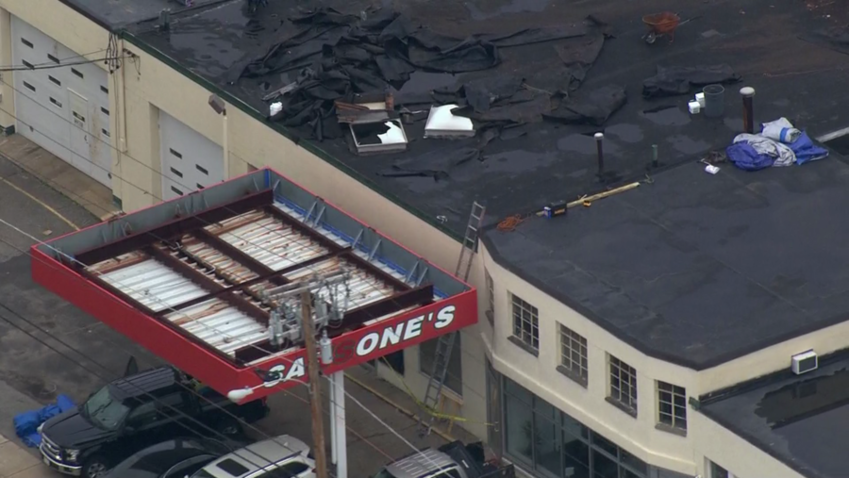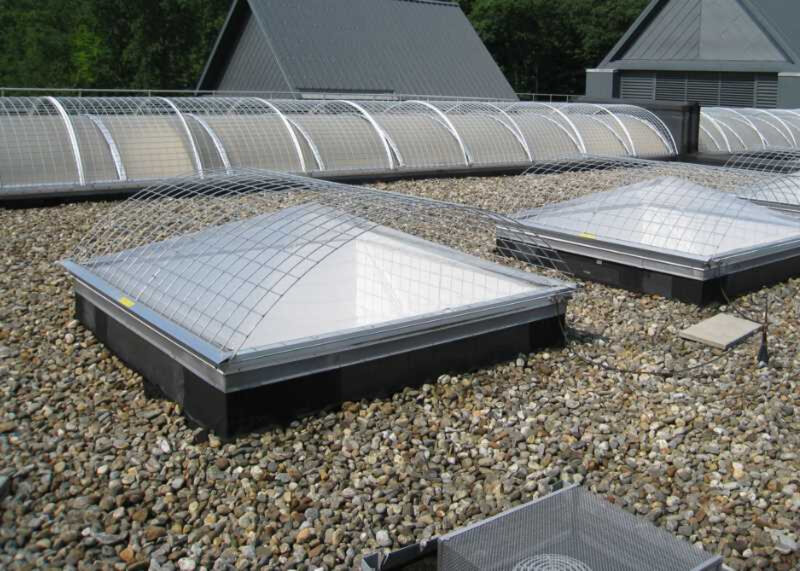
Skylight Fall Protection Systems
OSHA Compliant Skylight Fall Protection
OSHA defines a rooftop skylight as a hole in the roof surface and a hazard to anyone working or walking on the rooftop. Having the right fall protection to guard skylights is critical to ensure that any work area or walking surface is safe. Thankfully, there are a couple options to provide the best skylight fall protection.

Skylight Screens
Skylight safety screens are a wired mesh that surrounds the skylight, ensuring accidental falls or misplaced steps protect the worker and do not damage the skylight. The mesh is wide enough to let plenty of light through while being strong enough to promote safety. Skylight fall protection is vital in rooftop safety which is why skylight screens come in a variety of styles and sizes to fit most skylight types.
Learn More About Skylight Screens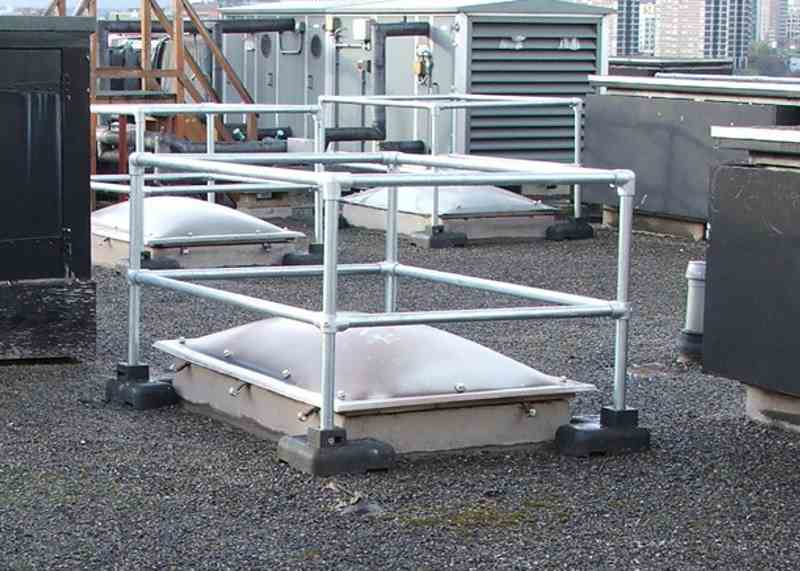
Skylight Guardrail
Skylight guardrail is a galvanized railing system designed to create a barrier around the skylight to prevent contact from a worker. Skylight guardrail uses non-penetrating railing that protects the skylight without damaging the structure or roof. Skylight safety is non-negotiable, that’s why we provide a variety of skylight guardrails to fit most roof types and ensure every skylight has fall protection.
Learn More About Skylight GuardrailOSHA Guarding Requirements for Skylights
1910.28(b)(3)
Holes. The employer must ensure:
1910.28(b)(3)(i)
Each employee is protected from falling through any hole (including skylights) that is 4 feet (1.2 m) or more above a lower level by one or more of the following:
1910.28(b)(3)(i)(A)
Covers;
1910.28(b)(3)(i)(B)
Guardrail systems;
1910.28(b)(3)(i)(C)
Travel restraint systems; or
1910.28(b)(3)(i)(D)
Personal fall arrest systems.
1910.28(b)(3)(ii)
Each employee is protected from tripping into or stepping into or through any hole that is less than 4 feet (1.2 m) above a lower level by covers or guardrail systems.
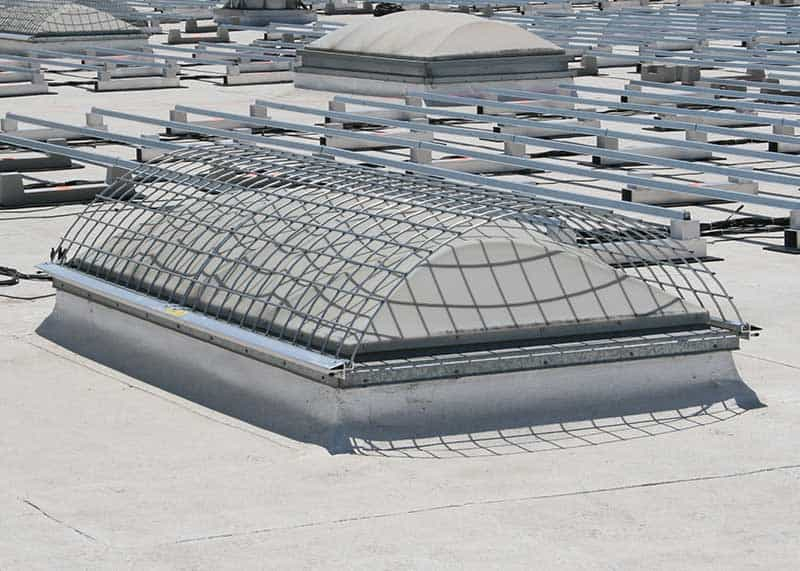
OSHA defines a hole as a gap or open space in a floor, roof, horizontal walking-working surface, or similar surface that is at least 2 inches (5 cm) in its least dimension.
OSHA gives no allowance for not protecting skylights. All skylights where a worker may be found shall be protected. Often, the 15-foot and 6-foot distance rules mentioned in 1910.28(b)(13) Work on low-slope roofs are used to justify a lack of fall safety. However, that code reference is specific to roof edges on a low-sloped roof.
The options for protecting rooftop skylights are a cover, a guardrail, or a personal fall protection system.
Guardrails and skylight screens (covers) are the most effective of the available options because they can be installed and left in place with no further action by the worker. No additional PPE is required.
Personal fall protection systems can be in arrest or in restraint. Fall arrest is difficult with skylights because of the potential issue with fall clearance. Often, skylights will not have enough vertical clearance below to prevent the user from impacting the lower level. Fall restraint will prevent a worker from getting to the skylight, but still requires extra training, PPE, and user commitment to the rules.
We’ve written a guide for horizontal lifelines if you want to dig deeper into this.
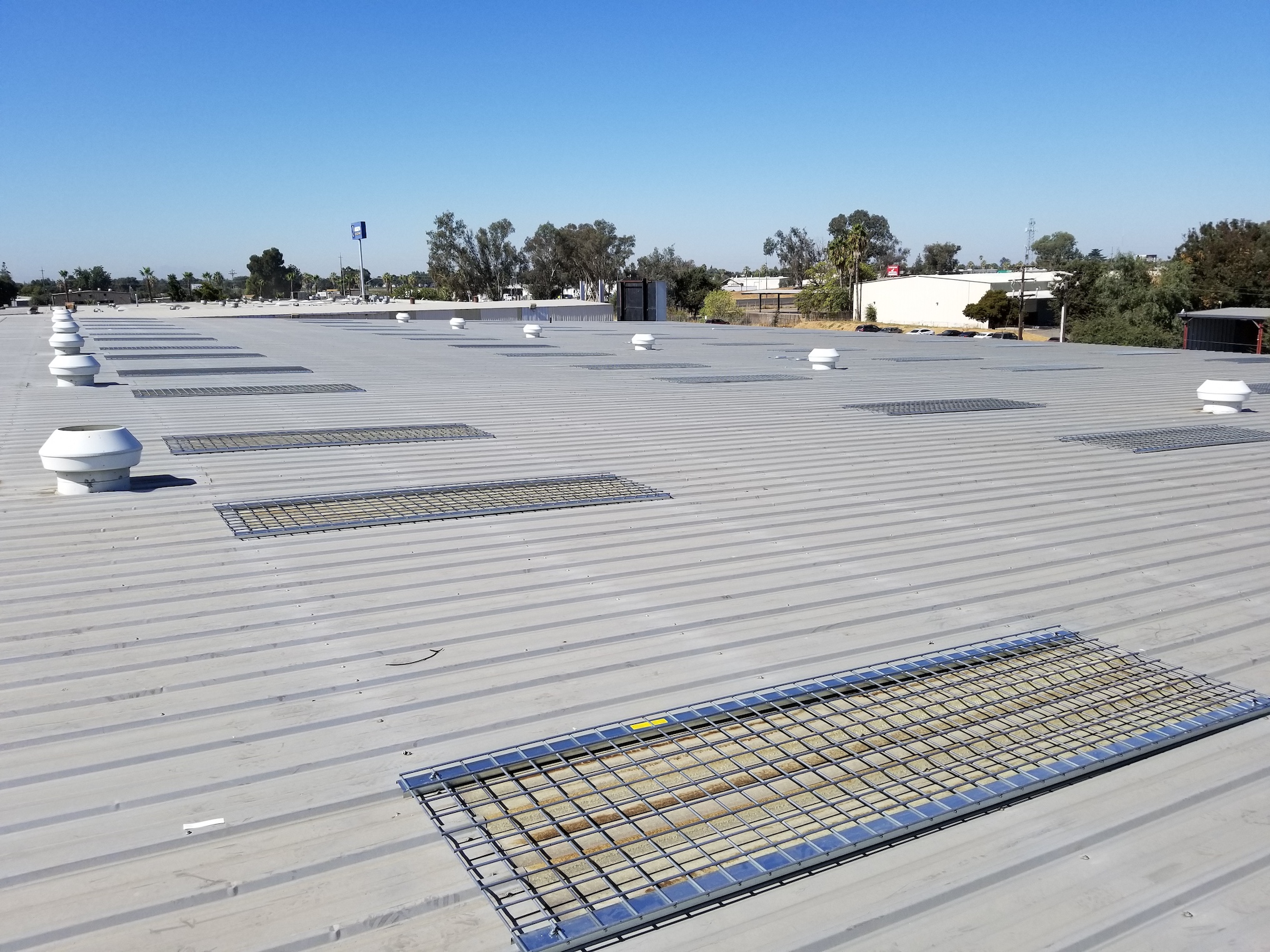
OSHA Skylight Covers Requirements
1910.29(e)
Covers. The employer must ensure each cover for a hole in a walking-working surface:
1910.29(e)(1)
Is capable of supporting without failure, at least twice the maximum intended load that may be imposed on the cover at any one time; and
1910.29(e)(2)
Is secured to prevent accidental displacement.
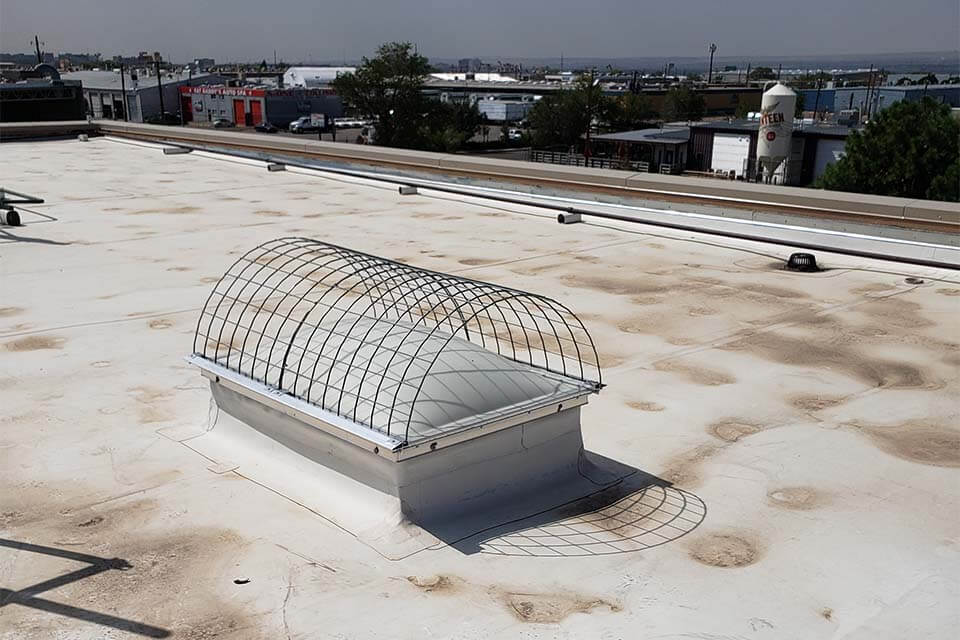
OSHA defines a maximum intended load as the total load (weight and force) of all employees, equipment, vehicles, tools, materials, and other loads the employer reasonably anticipates to be applied to a walking-working surface at any one time.
If you’re not sure what to use for your maximum intended load, then a good place to start is the personal fall arrest system codes. 1910.140(d)(1)(v) calls out a combined body and tool weight of 310 pounds as a compliant load for arresting a fall.
Remember to secure the cover so that it cannot be displaced by accident. This does not mean that non-penetrating skylight screens should not be used. It just means that it should be stable, secure, and not easily moved.
OSHA Skylight Guardrail Requirements
1910.29(b)
Guardrail systems. The employer must ensure guardrail systems meet the following requirements:
1910.29(b)(1)
The top edge height of top rails, or equivalent guardrail system members, are 42 inches (107 cm), plus or minus 3 inches (8 cm), above the walking-working surface. The top edge height may exceed 45 inches (114 cm), provided the guardrail system meets all other criteria of paragraph (b) of this section (see Figure D-11 of this section).
1910.29(b)(2)
Midrails, screens, mesh, intermediate vertical members, solid panels, or equivalent intermediate members are installed between the walking-working surface and the top edge of the guardrail system as follows when there is not a wall or parapet that is at least 21 inches (53 cm) high:
1910.29(b)(3)
Guardrail systems are capable of withstanding, without failure, a force of at least 200 pounds (890 N) applied in a downward or outward direction within 2 inches (5 cm) of the top edge, at any point along the top rail.
1910.29(b)(4)
When the 200-pound (890-N) test load is applied in a downward direction, the top rail of the guardrail system must not deflect to a height of less than 39 inches (99 cm) above the walking-working surface.
1910.29(b)(5)
Midrails, screens, mesh, intermediate vertical members, solid panels, and other equivalent intermediate members are capable of withstanding, without failure, a force of at least 150 pounds (667 N) applied in any downward or outward direction at any point along the intermediate member.
OSHA 1910.29 (b) defines the requirements that all guardrails need to comply with to meet the minimum standard of safety. This is true for a roof edge guardrail or for a skylight guardrail.
To break it down to its simplest parts, all guardrail needs to be:
There are mounted and non-penetrating options for guardrails that are both OSHA compliant.
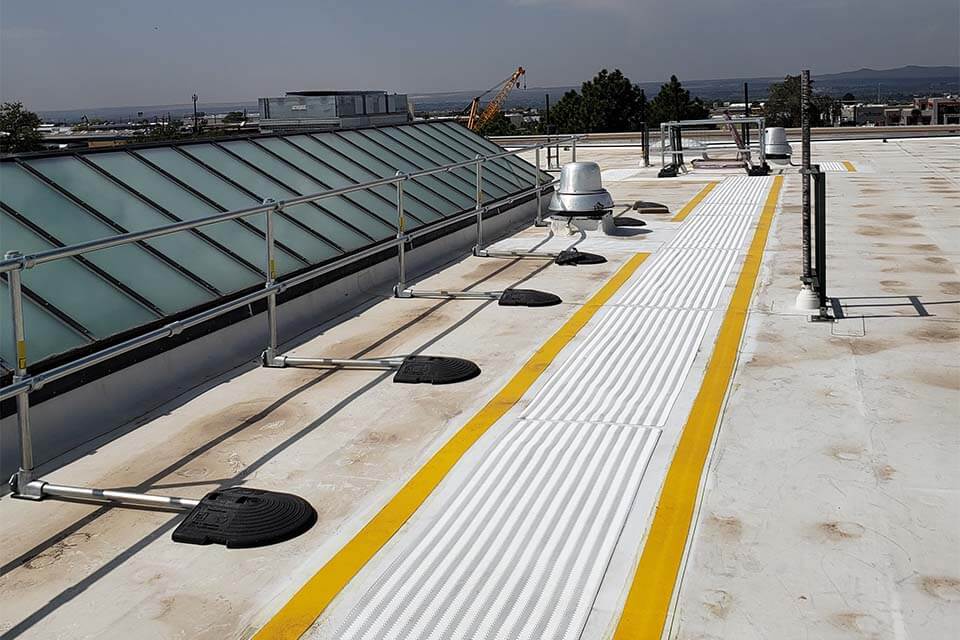
Cal OSHA Skylight Requirements
3212. Floor Openings, Floor Holes, Skylights and Roofs.
(b) Floor and roof opening covers shall be designed by a qualified person and be capable of safely supporting the greater of 400 pounds or twice the weight of the employees, equipment and materials that may be imposed on any one square foot area of the cover at any time. Covers shall be secured in place to prevent accidental removal or displacement, and shall bear a pressure sensitized, painted, or stenciled sign with legible letters not less than one inch high, stating: “Opening -Do Not Remove.” Markings of chalk or keel shall not be used.
(e) Any employee approaching within 6 feet of any skylight shall be protected from falling through the skylight or skylight opening by any one of the following methods:
(1) Skylight screens installed above the skylight. The design, construction, and installation of skylight screens shall meet the strength requirements equivalent to that of covers specified in subsection (b) above. They shall also be of such design, construction and mounting that under design loads or impacts, they will not deflect downward sufficiently to break the glass below them. The construction shall be of grillwork, with openings not more than 4 inches by 4 inches or of slatwork with openings not more than 2 inches wide with length unrestricted, or of other material of equal strength and similar configuration.
(2) Skylight screens installed below the skylight. Existing screens (i.e. burglar bars) shall meet the following requirements if they will be relied upon for fall protection:
(A) Screens installed at the same level or higher than the walking/working surface shall meet the strength requirements of subsection (b).
(B) Screens installed within 2 feet of the walking/working surface shall meet the strength requirements of subsection (b) with increased strength based on the fall distance below the walking/working surface as determined by a qualified person. In no case shall the strength of the screen below the skylight be less than the strength requirements of subsection (b). A screen more than 2 feet below the walking/working surface shall not serve as fall protection.
(C) A screen shall not be used for fall protection in accordance with subsection (e)(2)(A) or (e)(2)(B) if the broken skylight glazing will pose an impalement hazard to a worker who has fallen through the skylight and is lying on top of the screen. Skylights containing tempered, laminated, or plastic glazing, or similar materials shall not be considered to impose an impalement hazard.
(D) The screen construction shall be of grillwork, with openings less than 12 inches in the least horizontal dimension.
(3) Guardrails meeting the requirements of Section 3209.
(4) The use of a personal fall protection system meeting the requirements of Section 1670 of the Construction Safety Orders.
(5) Covers, including the skylight itself, meeting the requirements of subsection (b) installed over the skylights, or skylight openings. Where the skylight itself serves as a cover, the skylight shall be required to meet only the strength requirements of subsection (b). Further, for skylights serving as covers, the employer shall obtain documentation from the manufacturer that the skylight will meet the strength requirements of subsection (b) for the dates that work will be performed in the vicinity of the skylight. Such documentation shall be obtained prior to the start of work and shall be made available upon request.
(6) Skylight nets.
(7) A fall protection plan as prescribed in Section 1671.1 of the Construction Safety Orders when it can be demonstrated that the use of fall protection methods as contained in subsections (e)(1-6) of this Section is impractical or creates a greater hazard.
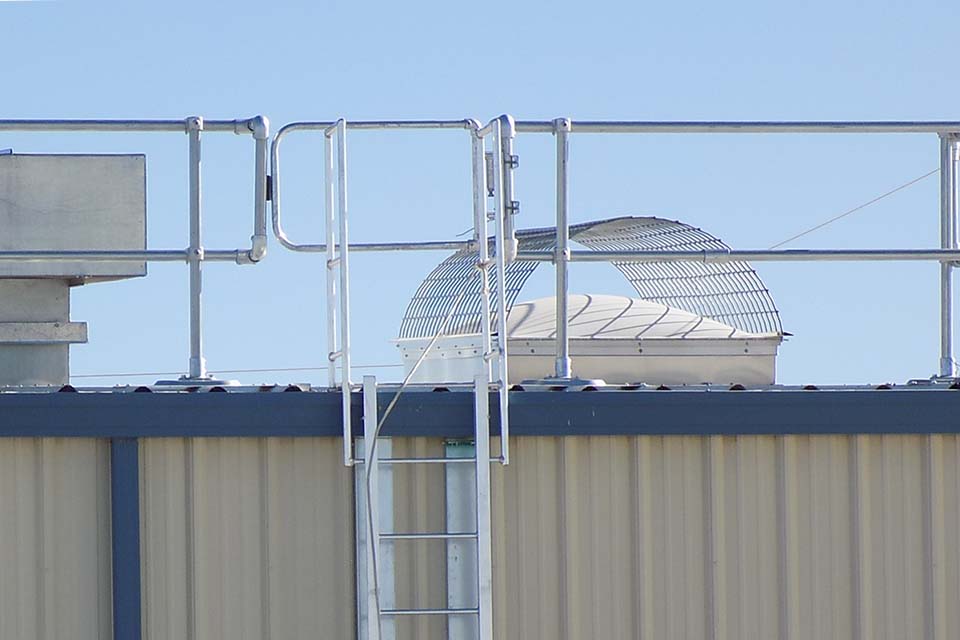
California OSHA’s standards are a little different than the Federal OSHA standards.
According to Cal OSHA, users walking within 6 feet of a skylight should be protected from falling through the skylight by a screen, guardrail, personal fall protection system, or netting.
Screens can be installed above or below the skylight. Screens installed above the skylight are generally considered to be covers and are the most common of the two options. Screens installed below the skylight would most be associated with burglar bars. Either option needs to be able to withstand twice the intended load or 400 pounds, whichever is greater. Consult a qualified person if the screen is going to be installed below the working / walking surface.
It’s also good to note that screens installed below the skylight are not compliant if the skylight can present an impalement hazard after a worker has fallen through.
It is possible that the skylight itself can be considered a cover. However, you will need documentation that can be presented upon request showing the skylight to be able to withstand the same load requirements. This documentation should include the dates for which these skylights can be used in such a fashion.
Nets are typically used in a temporary fashion and you can find out more about these at Cal OSHA3212 (e)(6).
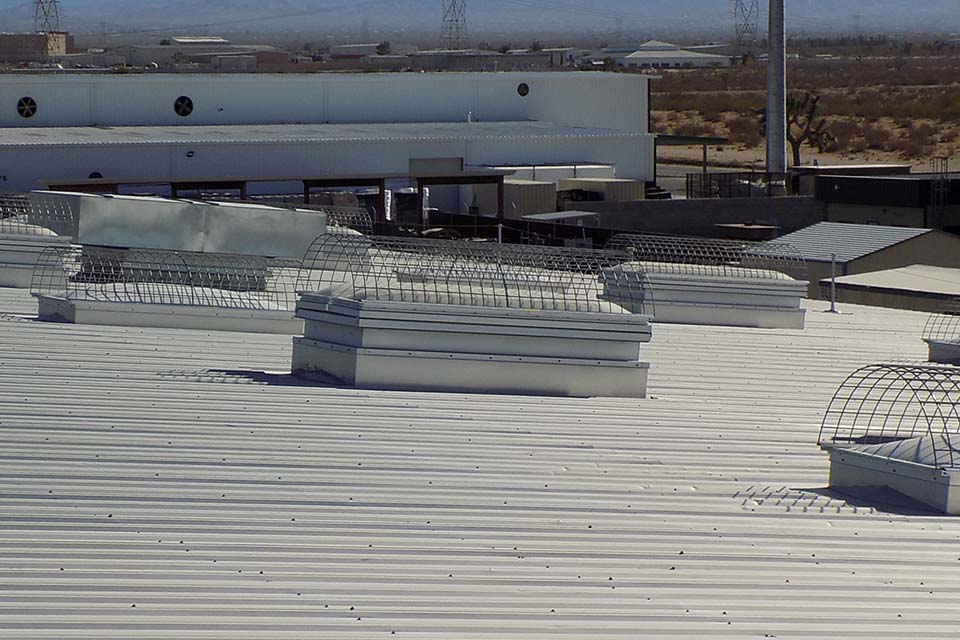
Cost of Doing Nothing with Skylight Safety
There are many different costs that you may think of when purchasing skylight fall protection. The biggest cost is one that is invaluable, human lives. Here are a few horror stories of what can happen by doing nothing with skylight safety.

West Chester man falls through Skylight to his Death

Man dies at Fairfield University after falling through Skylight
